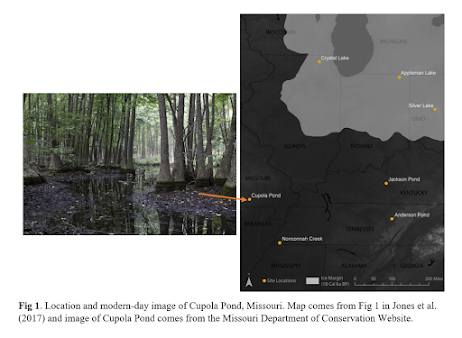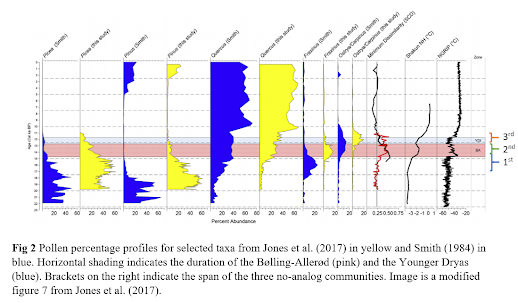Understanding the
ecological vegetation history of different regions allows us to understand
the interaction between organisms and large climatic changes. However, it also
allows us to use communities that do not have modern analogs to understanding
present-day flora formation. In a 2017 paper by Jones et al., they investigate
the vegetation history after the last glacial maximum (LGM) at Cupola Pond,
Missouri in the Ozark highlands (Fig 1). Not only did they link major
vegetation changes to major climatic changes, but they also provided sample
populations across three no-analog populations. This research allowed for a
better understanding of the history of the unglaciated southeastern United
States and an ability to understand new vegetation communities. The finding of
multiple no-analog communities also demonstrates that many sets of present-day
species may not have existed in the past.
While this link between population
shifts and larger climate events is important, the novelty of the study came
from samples collected to describe three different no-analog populations
between the LGM and the Holocene. No-analog communities are important because
it illustrates the large species range of vegetation and gives us a possible
future population that we could see if the climate continues to be altered.
However, findings of no-analog communities complicate our understanding of why
present-day flora exists in the way that they do. Sets of species that we see
today may not have a similar community in the past and thus we must investigate
why they appeared in that form. From 21,000 yr BP to 17,000 yr BP the
conifer-dominated forest had its modern-day analog in the modern boreal forest.
The first no-analog community began 17,00 yr BP and lasted until 15,500 yr BP
(Fig 2). The community had high Picea and Pinus, substantial Quercus, and low Fraxinus populations. The second non-analog community began
15,500 yr BP and lasted until the end of the Bølling-Allerød (Fig 2). It was
characterized by low Pinus and high Picea, Quercus, and Fraxinus
populations. Finally, the third no-analog community was between 12,700 yr BP to
11,00 yr BP (Fig 2). It is described as having declining Pinus, Picea, and Fraxinus populations while seeing a rise of Ostrya/Carpinus
and Carya populations. The presence of three non-analog communities
between the LGM and the Holocene signifies a high composition turnover and an
earlier beginning to the first no-analog community.
No-analog
communities and the link between vegetation transitions and climate changes
allows us to predict what the world could look like in the future. The
Quercus-Carya forests of the Conrad Environmental Research Area, where I have
collected plants, are most similar to the third no-analog community at Cupola
Pond but appear in Iowa. This shows how sets of species have shifted
geographically throughout time as the suitable environments have shifted. There
are still, however, differences in these communities demonstrating how we still
have gaps of knowledge in understanding why and how present-day communities
formed. We should use these no-analog communities to find the main ecological contributors
causing their formation and then look at the relationship between these factors
and modern-day populations.
Works Cited
Jones, R.A., Williams, J.W., Jackson, S.T., 2017. Vegetation history since the last glacial maximum in the Ozark highlands (USA): a new record from Cupola Pond, Missouri. Quaternary Science Reviews 170, 174–187. https://doi.org/10.1016/j.quascirev.2017.06.024


No comments:
Post a Comment